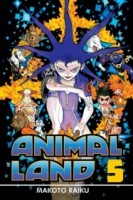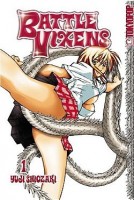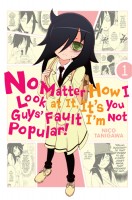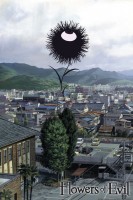My News and Reviews
Last week I announced the winner of the Sankarea manga giveaway. The post also includes a list of zombie manga that has been licensed in English, for those who might be interested. Considering the recent popularity of zombies, I was actually a little surprised to discover there weren’t more. I also posted two reviews last week. The first was for Makoto Kobayashi’s What’s Michael, Book Two, a fantastic cat manga sent to me by a Manga Bookshelf reader for review. My second review from last week was for Coffinman: The Journal of a Buddhist Mortician by Shinmon Aoki, which was the inspiration for Yōjirō Takita’s award-winning film Departures.
And now for a few things that I’ve come across online over the last couple of weeks. Crunchyroll Manga is now up and running. Deb Aoki wrote a good article about it for Publishers Weekly–Kodansha, Crunchyroll Talk Global ‘Simulpub’ Manga . At A Case Suitable for Treatment, Sean took a quick look at the manga series currently being offered through the platform–Kodansha and Crunchyroll Partnership: What Are We Getting?. Mostly unrelated, Kodansha posted on its Tumblr account a great summary of why some manga may never be licensed in North America, even if it’s really good. Rob Vollmar’s essay for World Literature Today “Dark Side of the Manga: Tezuka Osamu’s Dark Period” is actually from last year, but was recently brought to my attention again. And finally, the Comic Book Legal Defense Fund focused on Gene Luen Yang’s Boxers & Saints (which I think is one of the best comics to be released this year) as part of its Using Graphic Novels in Education column.
Quick Takes
 Animal Land, Volumes 5-8 by Makoto Raiku. It took a few volumes for Animal Land to really grow on me, but now that it has I find that I quite like the series. The occasional focus on scatological humor feels a bit out-of-place to me, though it seems to have become less common as the series progresses. The artwork in Animal Land is a little strange–a combination of realism and anthropomorphism–but generally engaging. The characters, particularly Taroza, are very likeable. I have enjoyed watching him grow up. A newborn at the beginning of the series, by the end of the eighth volume he has become a young man who has had to face the hard truths about his idealism. Taroza wants to put an end to the cycle of killing and eating, but to do so will require him to throw all of Animal Land into turmoil. He is not the only one who has an interest in shifting the power dynamics of the world–four other humans have made themselves known and have their own ideas about how things should be. I was a little surprised to see a bit of science fiction and time travel work its way into Animal Land, but I am very curious to see how things continue to develop.
Animal Land, Volumes 5-8 by Makoto Raiku. It took a few volumes for Animal Land to really grow on me, but now that it has I find that I quite like the series. The occasional focus on scatological humor feels a bit out-of-place to me, though it seems to have become less common as the series progresses. The artwork in Animal Land is a little strange–a combination of realism and anthropomorphism–but generally engaging. The characters, particularly Taroza, are very likeable. I have enjoyed watching him grow up. A newborn at the beginning of the series, by the end of the eighth volume he has become a young man who has had to face the hard truths about his idealism. Taroza wants to put an end to the cycle of killing and eating, but to do so will require him to throw all of Animal Land into turmoil. He is not the only one who has an interest in shifting the power dynamics of the world–four other humans have made themselves known and have their own ideas about how things should be. I was a little surprised to see a bit of science fiction and time travel work its way into Animal Land, but I am very curious to see how things continue to develop.
 Battle Vixens, Volume 1 by Yuji Shiozaki. Supposedly, Battle Vixens (aka Ikki Tousen) is somehow based on, or at least inspired by the classic Chinese historical novel Romance of the Three Kingdoms. Had I not known this going into the series, I’m not sure I really would have picked it up from reading the first volume. As far as I can tell, the references are barely there. (Which reminds me, I really do need to get around to finishing Romance of the Three Kingdoms.) What is readily apparent from the first page of the manga is that the English title, Battle Vixens was aptly chosen. The series is all about the fights and the fan service. There might be some sort of plot, too, but after only one volume I am still incredibly confused as to what is actually supposed to be going on. Basically there’s this girl, Hakufu Sonsaku, with a sizable chest and the penchant for getting into brawls. Towards what end? I am unsure. She simply seems predisposed to violence and having her clothes ripped off of her in the process. For a series based on fights the action unfortunately tends to be somewhat difficult to follow, but some of the panels have great composition.
Battle Vixens, Volume 1 by Yuji Shiozaki. Supposedly, Battle Vixens (aka Ikki Tousen) is somehow based on, or at least inspired by the classic Chinese historical novel Romance of the Three Kingdoms. Had I not known this going into the series, I’m not sure I really would have picked it up from reading the first volume. As far as I can tell, the references are barely there. (Which reminds me, I really do need to get around to finishing Romance of the Three Kingdoms.) What is readily apparent from the first page of the manga is that the English title, Battle Vixens was aptly chosen. The series is all about the fights and the fan service. There might be some sort of plot, too, but after only one volume I am still incredibly confused as to what is actually supposed to be going on. Basically there’s this girl, Hakufu Sonsaku, with a sizable chest and the penchant for getting into brawls. Towards what end? I am unsure. She simply seems predisposed to violence and having her clothes ripped off of her in the process. For a series based on fights the action unfortunately tends to be somewhat difficult to follow, but some of the panels have great composition.
 No Matter How I Look at It, It’s You Guys’ Fault I’m Not Popular!, Volume 1 by Nico Tanigawa. Okay, I’m just going to refer to this series by its Japanese abbreviation WataMote because I can never seem to remember the title in its entirety. (Plus, it’s really long.) WataMote is simultaneously one of the most funny and depressing manga that I’ve read recently. The story follows Tomoko Kuroki, an extraordinarily awkward and socially inept young woman who has just started high school. Most of her “life experience” has come from reading manga and playing video games, which may explain why she has difficulty interacting with her classmates. They mostly just ignore her or at least tolerate her existence. Occasionally she tries to be more than the weirdo in the corner, but it doesn’t often turn out well for her. I care about Tomoko and find her to be a sympathetic character which is why her trials and errors, though humorous, can also be a bit painful to watch. WataMote isn’t exactly mean-spirited, but it’s not particularly pleasant either. Her interactions with her younger brother are fantastically awkward (granted, all of Tomoko’s relationships are awkward), but there are some glimpses of familial love, too.
No Matter How I Look at It, It’s You Guys’ Fault I’m Not Popular!, Volume 1 by Nico Tanigawa. Okay, I’m just going to refer to this series by its Japanese abbreviation WataMote because I can never seem to remember the title in its entirety. (Plus, it’s really long.) WataMote is simultaneously one of the most funny and depressing manga that I’ve read recently. The story follows Tomoko Kuroki, an extraordinarily awkward and socially inept young woman who has just started high school. Most of her “life experience” has come from reading manga and playing video games, which may explain why she has difficulty interacting with her classmates. They mostly just ignore her or at least tolerate her existence. Occasionally she tries to be more than the weirdo in the corner, but it doesn’t often turn out well for her. I care about Tomoko and find her to be a sympathetic character which is why her trials and errors, though humorous, can also be a bit painful to watch. WataMote isn’t exactly mean-spirited, but it’s not particularly pleasant either. Her interactions with her younger brother are fantastically awkward (granted, all of Tomoko’s relationships are awkward), but there are some glimpses of familial love, too.
 Flowers of Evil directed by Hiroshi Nagahama. Based on the manga series by Shuzo Oshimi, the Flowers of Evil anime series is a phenomenal adaptation. It’s one of the rare cases where I might actually prefer the anime over the original manga. That being said, the anime is definitely not a series that everyone will be able to enjoy. First of all, the pacing is excruciatingly slow. It worked for me and I think it creates marvelous tension, but someone who needs a bit more action and forward movement from their anime will be very frustrated. Not much actually happens from episode to episode; the focus is more on the inner turmoil and crises of the characters. The animation also relies heavily on rotoscoping techniques, resulting in a style that doesn’t personally bother me, but I know plenty of people who can’t stand it. I think it was suitable for Flowers of Evil, creating a slightly disconcerting and surreal mood that fits the unsettling atmosphere and darker nature of the series. The use of music and silence in the series is also quite remarkable. The twisted triangle of a relationship between Kasuga, Nakamura, and Saeki is intense. The Flowers of Evil anime captures it perfectly using art film-like sensibilities.
Flowers of Evil directed by Hiroshi Nagahama. Based on the manga series by Shuzo Oshimi, the Flowers of Evil anime series is a phenomenal adaptation. It’s one of the rare cases where I might actually prefer the anime over the original manga. That being said, the anime is definitely not a series that everyone will be able to enjoy. First of all, the pacing is excruciatingly slow. It worked for me and I think it creates marvelous tension, but someone who needs a bit more action and forward movement from their anime will be very frustrated. Not much actually happens from episode to episode; the focus is more on the inner turmoil and crises of the characters. The animation also relies heavily on rotoscoping techniques, resulting in a style that doesn’t personally bother me, but I know plenty of people who can’t stand it. I think it was suitable for Flowers of Evil, creating a slightly disconcerting and surreal mood that fits the unsettling atmosphere and darker nature of the series. The use of music and silence in the series is also quite remarkable. The twisted triangle of a relationship between Kasuga, Nakamura, and Saeki is intense. The Flowers of Evil anime captures it perfectly using art film-like sensibilities.










 A whole bunch of new series from Kodansha have debuted this month, so I checked out a couple of those. The first was
A whole bunch of new series from Kodansha have debuted this month, so I checked out a couple of those. The first was  MJ: Well, I decided to make it a Kodansha week too, and the results surprised me greatly. First, I read the debut volume of
MJ: Well, I decided to make it a Kodansha week too, and the results surprised me greatly. First, I read the debut volume of 




